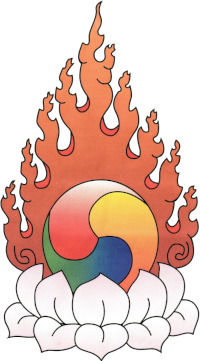Since it is Tibetan uprising day, let me tell you one thing: Tibetans have sacrificed so much for this tradition, this religion. Honestly. Today, there are political games and issues, but I am talking about generations, over a thousand years. First, Tibetans didn’t get proper Buddhist teachings, and suffered for 500 or more years, sacrificing the lives of their rulers and teachers, in order to get the great Indian treasure of Buddhism. It is the one what helps, and sees no difference between people, the one what cares for all, the one who is supposed to have the proof of something better. That’s why Tibetans suffered for generations to get that. It’s because of geographical reasons. Tibet is cold and dry up there in the Himalayas and when you go to India you get into the heat and you can die. Indian masters won’t come up to Tibet much, even though the Tibetans begged them. One or two great Indian teachers did come. Unwanted many of them, those who came as half religious teacher – and half business people. So many of them came in Tibetan history. It’s just like what they are doing today. Different Tibetans and Chinese and Indians come in under the title of this master and that master. That happens today. And the same thing was done before to the Tibetans 1500 years ago.
After that, it became a pure Buddhist teaching, and began to establish itself after hundreds of years of struggle. Then later, Tibetan sacrificed modern development, completely, in order to save this great tradition. Honestly. They did that with choice. They knew it. They thought that the snow mountains would keep foreigners out. But no, they forgot there is something called airplanes. Actually, they knew there was modern development. We knew it very well. When I was a kid, I knew that. But, Tibetans chose not to have that, just to preserve the pure teaching. Fortunately or unfortunately, in 1959, BOOM, it scattered everything. Everybody was crawling out, running around, and whoever was left, got tortured or killed. His Holiness came out of Tibet and was followed by so many. And that’s how this teaching is available today – as a dying culture. An endangered species. At the same time, it helps a lot of people, too. It doesn’t only help Indians and Tibetans, but so many people. So, that’s why it is here. With so much sacrifice of so many people, over so many generations for that, that’s why it is here today.
Now, what is the easy way to grasp its essence? Do I have to be worshipping Buddha? Do I have to attend to Buddhist temples? The answer is very definitely, no. In order to get the benefit out of this, you don’t have to be Buddhist or a Buddha worshipper. The subject of worship itself is very questionable in Tibetan Buddhism.
It is true, there are monasteries, temples and images and people do circumambulations and give feasts at monasteries. All of those are there. Everything is there. However, it depends on the individual person. In Tibetan Buddhism, there is tremendous philosophy and theological ideas. Also, it is very simple and very easy. Bottom line, it will boil down to yourself and your own thoughts. It is simply what you want. We know we don’t want any misery, and we know that even the lack of misery becomes misery. So all of those we don’t want. What we do want is really, truly, happiness and joy. That is the bottom line from our side. The theory, philosophy, idea, and this experience that Buddha gained, what does that offer in that context? Very simple. It depends on ourself, not on anything else. So the first and foremost, is that we want to be happy. We want to be helpful to ourselves, to me and our family and everybody and to anyone who even comes in the slightest contact with you, either through personal dealings, or through reading or hearing the message. All of them need to be helpful.
Where does help begin? With good thoughts. What is a good thought? The idea of helping, of not harming, not hurting. We always have it, in our blood, that “I want to have the gain, no matter what the cost, at the expense of whoever it may be.” We are willing to sacrifice anybody else for our own personal joy and happiness. That is the wrong thought. This is the thought to be negated. The thought to be removed from our mind, completely. Then it should be substituted with helping myself as well as others. So remove the thought, “I want to gain, I want to gain” and replace that with, “I want to gain and help.” That’s not difficult, particularly for people like yourselves, with education, with good character, good nature. It is not difficult. Not at all. It is only not impossible, but it is definitely possible. You can do it. You will do it. That will cost you nothing, and give you joy and happiness. The seed is laid with you. You have it in your own nature. You have it from your own background. From whatever it is. You do have that. Keeping that, developing that, is the beginning of a really simple way to, when we say, “Change your motivation.” That is everything.
It doesn’t have to be sitting down and meditating and saying prayers alone. That is for all the time. Everything, whatever you do. It is one thought at the beginning, for 24 hours. When that thought becomes weaker, within six hours, or four hours, or two hours, or even half an hour. Remind yourself. Keep that thought morning through evening. So the principle of your life is turned right. We’ve got to start somewhere. This is where we start.
Those of you who have a background in a great tradition, doing great. Congratulations. Keep it up. Make it better. But those of you who would like to begin, particularly the younger ones, who would really like to do something. It will cost you no money. It will cost you nothing. It will bring you a lot of joy. A lot of happiness. That’s what we do. Where you begin.
But, changing the thought, your motivation, alone will not do. Keep that influence functioning throughout the day. Then in the evening, you look back, and your day is okay. Not that bad.
~ Gelek Rimpoche, March 10, 2013, Jewel Heart Ann Arbor


